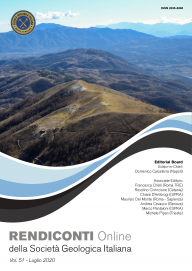
The aluminum and iron mines of the Comino Valley-Sora area (Central Apennines, Italy): sites of the geological memory
Angelo Cipriani
Dipartimento di Scienze della Terra, "Sapienza" Università di Roma. Piazzale Aldo Moro 5, 00185 – Roma
Corresponding author e-mail: angelo.cipriani@hotmail.it
Volume: 51/2020
Pages: 9-24
Abstract
The Mesozoic bauxitic-limonitic deposits of the Comino Valley- Sora area have been exploited since proto-historic times, but this area became crucial for the “iron rush” in the Bourbon era. The Kingdom of Naples decided to finance scientific researches in the area between Pescosolido and Picinisco (southeastern Lazio), in order to strengthen military defenses and to combat invasive or rebellious pressures. This led to the realization, in the period between 1770 and 1860, of the Royal Mines of Canneto, San Donato Val di Comino and Campoli Appennino, and of the Royal Forges of Canneto and Rosanisco. Fundamental was the supervision of technicians, including the engineer and geologist Gaetano Tenore. Following the Bourbon crisis of 1860, the industrial activity of the area was abandoned with, in many cases, its definitive loss of evidence (e.g. many of the mines of Campoli and San Donato Val di Comino, as well as the Canneto forge). The geological relevance of the mineralogical and stratigraphic studies performed in this area (with their socio-cultural and economic implication), coupled with the fact that most of this geological heritage is disappearing, allowed to identify several “sites of geological memory” in this area.
Keywords
mines, bauxites, limonites, Mesozoic, Gaetano Tenore, Campoli Appennino, San Donato Val Comino, Pescosolido, Rosanisco Forge, Canneto Forge, History of Geology.
Get Full Text